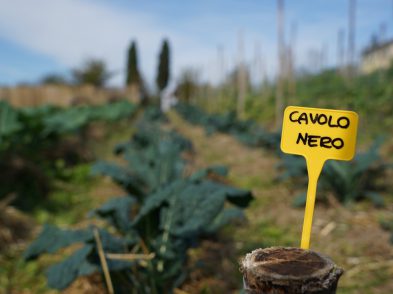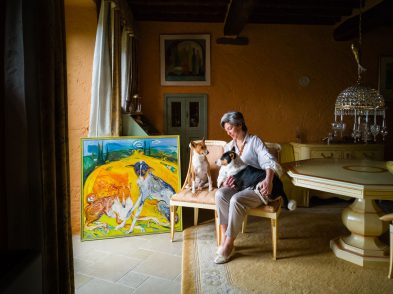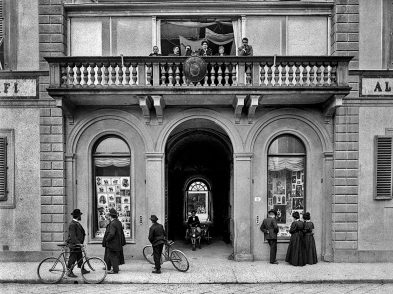A small exhibit at Villa Bardini, Il Rinascimento da Firenze a Parigi: Andata e ritorno, is worth the hike up Costa San Giorgio. Thirty works that now form the Italian nucleus of the Jacquemart-André museum in Paris were sold to Nélie Jacquemart at the end of the nineteenth century by the antiquarian Stefano Bardini, and this is the first time they have returned to Florence. Mantegna, Botticelli, Paolo Uccello and other big names are part of this exquisitely displayed temporary show.
Perhaps a dozen people were in the museum on the first weekend of the exhibit’s opening, and most spoke in hushed whispers, knowingly looking at the paintings and marveling over them. While many are by famous artists, I have never seen most of them, and I think the excitement was mutual for the other visitors.

The interesting story behind this collection is told through a few large bilingual panels. Edouard André, heir of a Protestant banking family, began collecting knick-knacks in the 1860s. In 1872, he went to have his portrait painted by a renowned female portraitist, Nélie Jacquemart. He married her. Although she was a Catholic royalist and the marriage was rather set up, it turned out to be a success. She took over the acquisition of paintings, and the Italian collection we see today is mostly her doing. The couple traveled constantly, often to Italy, and purchased much art to put in their fantastic large mansion on Boulevard Haussmann, which was completed in 1875. The collection was willed to the French state on Nélie’s death.
Through correspondence with and frequent visits to the Florentine collector Stefano Bardini, whose collection is in the Museo Bardini (via de Renai 37, near the Ponte alle Grazie), the couple acquired 82 works from Florence, 30 of which are temporarily ‘at home’ in Villa Bardini.

The painting that most grabbed me was Mantegna’s Ecce Homo from around 1500, with an elaborate contemporary frame. The colours are muted and almost fresco-like, similar to his Lamentation over the Dead Christ at the Brera museum in Milan, which is tempera on canvas. The texture of the canvas is visible beneath the thinly applied paint.
Keith Christiansen, curator at the Metropolitan Museum of Art, says in his monograph on Mantenga that his art ‘demands and repays the closest viewing; it requires an engaged viewer.’ Engaged I was as I first was drawn to the piece, then looked closer, then stepped to the side… then noticed that the painting contains not three figures (Christ and two accusers) but two further ones that are almost shadows. Christiansen parallels the technique used here to rilievo schiacchiato, or flattened relief (by Donatello) in sculpture. The ‘hidden’ figure on the left seems almost to be a reflection or double image of the main, Jewish accuser (he has faux-Hebrew writing stuck to his head), as the grotesque profile is repeated in the shadowy figure. On the right, the secondary figure is shown frontally. If this were a modern photograph, the ‘shadow’ figures would represent motion and help increase the sense of repeated, relentless attack. In a small painting and with very little paint, the artist gives an incredible impression of depth, both by crowding figures around Christ and by ‘affixing’ two pieces of paper (they are juridical indictments) to the top.
Another highlight of the collection is St. George and the Dragon by Paolo Uccello, a small and rather strange panel with a very medieval feel to it. It depicts the saint on a bucking horse, driving a lance into a dragon while a not particularly distressed damsel looks on. The horse seems to have walked right out of the large battle scene you may have seen in the Uffizi—Uccello’s three-panel Battle of San Romano (the other two panels are in Paris and London). Uccello was obsessed with perspective, and here he uses plots of farmed land to create a perspectival grid and give a (rather artificial) sense of depth. Look closely and you will spot, in the background, a cardinal (in red) speaking animatedly with two other figures.
Nélie Jacquemart seems to have been fond of Botticelli: she collected a few works by him and his workshop, and one room in this small exhibit is dedicated to these works. A large tondo (circular painting) of the Virgin and Child shows the hand of the workshop more than of the master, while a panel from 1510 representing the Flight into Egypt is attributed to Botticelli. The tender exchange between mother and child, the sultry look of the donkey, the decorative nature of the landscape are all elements that would have appealed very much to the nineteenth-century mind, and one can see how this painting might have influenced painters of that period.
Just four small rooms hold these works of art, but it is absolutely worth the admission price of 8 euro (6 euro for members of various associations, including those with a Coop card). Admission to the exhibit also gets you into the Bardini garden, a wonderfully well-maintained and shady space for a relaxing stroll before or after the exhibit.
Il Rinascimento da Firenze a Parigi: Andata e ritorno
Until December 31, 2013
Villa Bardini, Costa San Giorgio 2, Florence







